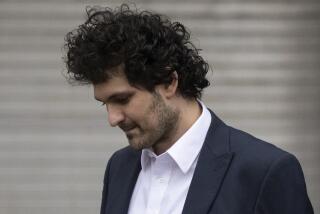Q&A: Q&A: Anat Admati on ‘What’s Wrong With Banking and What to Do About It’

- Share via
Anat R. Admati, a professor of finance and economics at Stanford’s business school, is an unlikely player in Washington’s financial reform scene.
The 58-year-old Israeli-born economist arrived at Stanford in 1983 with an interest in mainstream financial issues and a firm belief that markets — with their unique ability to assign a price to risk and channel capital to its most efficient use — were a powerful force for good.
The 2008 financial crisis upended that faith. She turned her gaze to the industry at the center of the crisis: banking.
Admati made waves on the national financial reform scene in 2013 with the book “The Bankers’ New Clothes: What’s Wrong With Banking and What to Do About It,” coauthored with economist and banking expert Martin Hellwig.
In conversational prose, the book patiently explains basic banking concepts and forcefully argues for a new paradigm of bank regulation, one that looks less at what banks do with their money and more at where their money comes from: Is it borrowed or their own?
She argues that requiring banks to rely more on shareholders’ money instead of borrowing funds would increase stability, harness market forces to deter risky behavior and lead to a smaller, safer system as banks pulled back on bets that didn’t make financial sense.
Her arguments have drawn fierce pushback from the banking industry, but got the attention of financial policymakers. They also earned her appointments to advisory committees to the Federal Deposit Insurance Corp. and the Commodity Futures Trading Commission, as well as an invitation last summer to the White House.
So what’s a bank to do? We recently caught up with Admati, and here’s an excerpt of our talk:
Why did you write “The Bankers’ New Clothes,” a book for the general public and not strictly for scholars?
We thought we had to. There was, I thought, a certain lack of engagement on the part of many academics, and it was disturbing to me that there was not enough serious discussion about what was going on.
I was not a banking expert, but after studying it, I found that a lot of policymakers and people commenting on it didn’t actually know what they were saying or were saying wrong things or misleading things.
There seemed to be, to take a charitable interpretation, that there were blind spots or confusion or, the most cynical interpretation, there was sort of willful blindness.
How did you get so involved in Washington financial policy circles?
From the beginning, I tried very hard to engage with anybody in Washington who would engage with me. It started by being appointed by Sheila Bair [then the FDIC chairwoman] to a committee in the spring of 2011, which just allowed me into the room at all. [Former Fed Chairman] Paul Volcker is on it. [Dartmouth economist] Peter Fisher is on it.
I met Senate staffers, then Sen. Sherrod Brown [D-Ohio] and other senators. Most of the people I met were Democrats, but there were also some Republicans, like David Vitter [of Louisiana]. So, like that. It was just developing, one person to another.
Then after the book came out, other people started paying a little more attention, and that’s how I got even invited to the White House.
So, what’s wrong with banking?
What’s wrong with banking is that a lot of people are able to take risks and not be fully responsible and accountable for those actions. They can get away with doing things that are really inefficient and dangerous, somehow. And it works for them but it’s dangerous for the rest of us.
People need to understand that the biggest banks are really, really big, by any measure. Just how much is a trillion? It’s an enormous number. They are larger than just about any corporation, so it’s not just big. It’s really very, very big.
It’s also the complexity and sort of breathless scope of what they do and just how much of it is opaque. It remains incredibly fragile as a system.
Why is a bank’s equity important?
Equity is like a down payment on a house. It’s money from shareholders, not borrowed, and that’s what most corporations live on primarily. Some corporations don’t borrow at all.
The question is, just how much reliance on debt should banks have?
Is it the same as bank capital, which we usually hear about?
Essentially, yes, but think of equity as the best form of capital. Capital is often misunderstood as a rainy day fund, money that sits on a shelf until it is needed to absorb losses. That’s false.
The word “capital” is one of the world’s most misunderstood words. When we talk about capital we think about machines.
But in banking, and only in banking, the word “capital” is meant to represent where the money comes from. And really what regulatory capital means is essentially money that’s unborrowed.
Capital requirements, boiled down, amount to a few percentage points of a bank’s total assets. What’s the right ratio?
Current requirements are ridiculous by any normal standards. A supposedly “harsh” regulation would be 5% of the total. Corporations just never ever live like that.
I talk about 20%-30% of assets, but what’s really complicated is how you measure assets. The way assets are measured now pretends to be scientific, but the rules are designed in a flawed way. I want simpler measures and for capital to be 20%-30% of the total.
Where would banks get all this capital?
Stop paying dividends, for one thing. If you just invest profits, you immediately have more money. That’s how Warren Buffett lives. He hardly ever pays out and just invests it back in the business.
If they don’t have profits or can’t raise equity by selling stock, then you have to wonder about their business model.
You’ve heard the argument many times from the finance industry: The more capital you require, the more you withhold from lending. It’s money taken out of the economy.
That’s ridiculous. That’s utter nonsense. You’re talking about where the money comes from, not what they can do with it. More capital does not constrain what they do. It just makes what they do safer for the rest of us.
More to Read
Inside the business of entertainment
The Wide Shot brings you news, analysis and insights on everything from streaming wars to production — and what it all means for the future.
You may occasionally receive promotional content from the Los Angeles Times.











